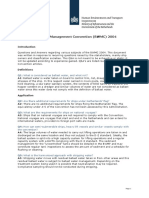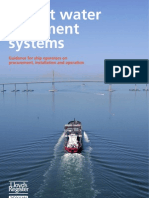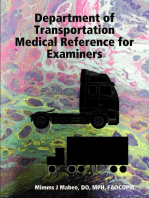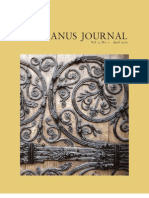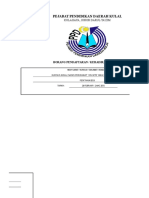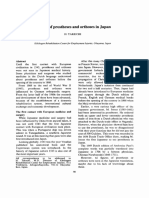2019 BWM Checklist Rev 0
2019 BWM Checklist Rev 0
Uploaded by
cristianvoinea13Copyright:
Available Formats
2019 BWM Checklist Rev 0
2019 BWM Checklist Rev 0
Uploaded by
cristianvoinea13Copyright
Available Formats
Share this document
Did you find this document useful?
Is this content inappropriate?
Copyright:
Available Formats
2019 BWM Checklist Rev 0
2019 BWM Checklist Rev 0
Uploaded by
cristianvoinea13Copyright:
Available Formats
US Regulatory Update: Ballast Water Management Checklist 2019 Revision 0
FEDERAL BALLAST WATER MANAGEMENT
This applies to ALL non-recreational vessels that are equipped with ballast tanks and operate in the waters
of the United States. This does NOT apply to foreign vessels engaged in innocent passage.
To discharge ballast water into the waters of the U.S., applicable vessels must employ ONE of the following
ballast water management methods:
Perform a complete ballast water exchange 200 nautical miles from any shore prior to discharging
ballast water in the US. This method will no longer be accepted if per the USCG and EPA
1
implementation schedule the vessel is required to have installed a BWTS, unless the vessel has
received an extension from the USCG.
Install and operate a ballast water treatment system (BWTS) that is type-approved by the USCG in
2 accordance with the USCG and EPA implementation schedule, included below. Use of the treatment
system is required for all discharges in US waters, regardless of where the ballast water is sourced.
There are now several ballast water treatment systems that have received USCG type
USCG approval. A complete list of the current USCG type approved systems is available on
TYPE CGMIX at: http://cgmix.uscg.mil/Equipment/Default.aspx.
APPROVED
SYSTEMS BWMS type approval certificates and status of pending applications are also available
on the USCG’s website – Homeport: Approved BWMS and Status of Applications
Install and operate an Alternate Management System (AMS) accepted by the USCG prior to the date
that the vessel is required to comply with the ballast water discharge standard (BWDS). Use of an AMS
3
will be allowed for up to 5 years after the vessel’s compliance date. Use of the treatment system is
required for all discharges in US waters, regardless of where the ballast water is sourced.
Ballast exclusively with water from a US public water system (PWS)
4
This option may NOT be a viable option based on vessel operations
Discharge to a facility onshore or to another vessel for purposes of treatment
5
This option is NOT currently available in US ports and terminals.
Do not discharge ballast water into waters of the United States (within 12nm).
6
This option may NOT be a viable option based on vessel operations.
USCG AND EPA IMPLEMENTATION SCHEDULE FOR APPROVED BWM METHODS
Ballast Capacity Date Constructed Compliance Date
New Vessels All On or after 12/01/2013 On delivery
1st scheduled drydocking
< 1500 cbm Before 12/01/2013
after 01/01/2016
1st scheduled drydocking
Existing Vessels 1500 – 5000 cbm Before 12/01/2013
after 01/01/2014
1st scheduled drydocking
> 5000 cbm Before 12/01/2013
after 01/01/2016
The IMO Ballast Water Management (BWM) Convention officially entered into force on
September 08, 2017.
IMPLEMENTATION The implementation schedule and compliance requirements for the BWM Convention
OF THE are separate from the USCG and EPA Requirements. An extension received by the
IMO BALLAST USCG has no impact on compliance obligations under IMO, and likewise the
WATER compliance date for meeting the IMO standards are separate from obligations to meet
MANAGEMENT US requirements.
CONVENTION Additional information on the implementation of the BWM Convention is available at –
http://www.imo.org/en/OurWork/Environment/BallastWaterManagement/Pages/Default
.aspx
© O’Brien’s 2019 | www.obriensrm.com | 24 HR: +1 281 606 4818 | inquiry@wittobriens.com 1
US Regulatory Update: Ballast Water Management Checklist 2019 Revision 0
The USCG has stated that they will continue to consider extension requests, despite the
availability of USCG type approved systems. However, any owner/operator requesting an
extension must provide USCG with an explicit statement supported by documentation as to
why compliance with the current requirements is not possible for your vessel, as well as a
strategy for how the vessel will come in to compliance.
Any existing extensions will remain valid until the extended compliance date specified in the
USCG extension letter. Upon expiration of the extension, a vessel owner or operator will need to
implement one of the approved ballast water management methods listed above, or apply
EXTENSION for a supplemental extension.
REQUESTS
An extension will only be granted for the minimum amount of time needed to come into
compliance with the USGC requirements, as determined by the USCG, but not more than
12 months from the vessel’s original compliance date and will not be tied to the vessel’s
next scheduled drydock. The USGG will not issue extensions for vessels equipped with an
AMS approved treatment system, even if the system is inoperable.
Links to the USCG policy letters and application spreadsheet are included on the next page.
EXTENSION APPLICATIONS The following elements are required for USCG extension requests:
New applications should be submitted between 12-18 months before the vessels compliance
1 date. For supplemental extensions, the application should be submitted 12 months prior to the
expiration of the current extension.
2 Use the spreadsheet application provided by the USCG (linked below)
3 Send the application and all supporting documentation to environmental_standards@uscg.mil.
The request must provide an explicit statement supported by documentation as to why the
installation of one of the available a type approved system is not possible.
Examples of additional documentation in support of extension requests include:
• Written correspondence between the owner/operator and the applicable BWMS
manufacturer(s) that confirm BWMS are not available for installation on that particular
vessel or class of vessels until after the compliance date.
4
• Vessel design limitations with type approved BWMS currently available.
• Safety concerns related to installing type approved systems currently available.
• Any other situation that may preclude a vessel from being fitted with a type approved
system.
You must include an evaluation of all USCG type approved systems currently available. See the
link on page 1 for the most recent list of USCG type approved systems.
The request must include a strategy, or plan, for how the vessel will come in to compliance with
the regulations. Specifically, this should include a timeline, for when the owner/operator intends
on install a treatment system.
5 If you have not yet selected a system, you should submit a detailed analysis of how you intend to
match the vessel with an approved BWMS before the end of the extension. Specifically, what
system specifications do you need to match your operating profile, which system works best for
your vessel, and how/when are you going to install the system that satisfies those needs?
The request must include an explicit statement on why the other compliance options are not
available for your vessel. Including:
1. Use only water from a U.S. public water system (PWS),
• If this is not an option for your vessel, include a statement that you are unable to solely
use U.S. public water for ballasting operations
6 2. Do not discharge ballast water into waters of the United States
• If this is not an option for your vessel, include a statement that you are unable to
exclusively hold your ballast water while operating in the U.S.
3. Discharge to an onshore facility or to another vessel for purposes of treatment.
• There are currently no onshore facilities or treatment vessels in the U.S. so this is not an
option available to your vessel.
Do NOT attach a copy of your BWMP as it is not required and the USCG has a limited size of
7
correspondence they can receive (10mb).
© O’Brien’s 2019 | www.obriensrm.com | 24 HR: +1 281 606 4818 | inquiry@wittobriens.com 2
US Regulatory Update: Ballast Water Management Checklist 2019 Revision 0
Application Spreadsheet and Additional Resources:
• USCG BWM Extension Application
• NVIC 01-18: Ballast Water Management for Control of Non-Indigenous Species in Waters of
the United States
• Updated Extension Guidance: OES-MSIB No. 03-17
• USCG BWM Extension: Tips for Application
• BWMS FAQs – April 2018
If either an AMS or USCG type approved system becomes suddenly inoperable while
the vessel is en route to a US port or during operation in US waters, you must report
the issue to the local USCG Sector office as soon as possible. Approval to carry
out ballast water exchange must be obtained from the District Commander of the
applicable Captain of the Port (COTP) prior to discharging in US waters. In the event
the BWTS becomes suddenly inoperable, the following actions should be taken:
• Report the issue to both the nearest COTP to where the issue was discovered and
the COTP for the US port call, as soon as possible.
• Identify the issue and the proposed repair timeline, including details on the
availability of repair parts and/or service technicians.
• Be prepared to discuss alternative ballast water management strategies available
REPORTING to the vessel based on the vessel capabilities, routing, and voyage duration.
INOPERABLE Alternative strategies may include–
TREATMENT o Retaining the ballast water onboard while in US waters
SYSTEMS TO o Discharging any untreated ballast outside of 12nm
USCG o Completing ballast water exchange outside of 200nm at 2000m depth
o Discharging to an onshore reception facility
o Obtaining ballast from a US public water supply
The USCG will determine what actions need to be taken for the vessel to be authorized
to discharge untreated ballast in US waters. The USCG has stated not having an
adequate supply of chemicals or other treatment materials will not be considered an
acceptable reason to use an alternative management method, including deep sea
exchange. The USCG may ultimately not allow the vessel to discharge ballast in
US waters, and any discharge of ballast will need to occur outside of 12nm.
The Ballast Water Management Report submitted to NBIC does not substitute for
notification to the COTP in the event a BWMS stops operating properly.
If you have any questions or concerns regarding the applicability of ballast water
QUESTIONS? management requirements, extension requests, or reporting inoperable systems,
please contact us at inquiry@wittobriens.com.
All vessels that are discharging ballast water treated with either a USCG type approved
or AMS system must conduct analytical monitoring required under the Vessel General
ANALYTICAL Permit (VGP). The VGP requires analytical monitoring for biological indicators, such as
MONITORING FOR E. coli, and for residual biocides for systems that use chemical treatment. These
BALLAST WATER samples are required to be taken two (2) times per year and can be conducted by any
laboratory that uses EPA approved analytical methods.
TREATMENT
SYSTEMS • Summary of the monitoring requirements for the VGP
• EPA Vessel Discharge and Sample Collection and Analytical Monitoring
Reference Guide
SAMPLING Every vessel MUST have a sampling port(s) to collect representative samples of the
PORTS vessel’s ballast water. Sampling ports must be located:
As close as practicable to the BWMS prior to treatment to determine concentrations of living organisms
1
upon uptake.
As close as practicable to the BWMS overboard outlet prior to the discharge point to determine
2
concentrations of living organisms prior to discharge.
3 Elsewhere as necessary to ascertain the proper functioning of the BWMS.
© O’Brien’s 2019 | www.obriensrm.com | 24 HR: +1 281 606 4818 | inquiry@wittobriens.com 3
US Regulatory Update: Ballast Water Management Checklist 2019 Revision 0
Vessels may continue managing ballast using deep sea exchange (at least 200nm
offshore and 2000m depth) until their original compliance date (per the USCG and
EPA implementation schedule), or revised compliance date if an extension has been
BALLAST WATER granted.
EXCHANGE
Vessels calling the U.S. Great Lakes, New York, Oregon, or Rhode Island with an
approved ballast water treatment system may be required to conduct deep sea
exchange in addition to using the treatment system prior to discharge.
Vessel are NOT required to deviate their voyages out to 200nm and 2000m depth to conduct a deep sea
ballast exchange, if the voyage does not take the vessel into waters 200nm or greater from any shore for a
sufficient length of time. For example, if arriving from a coastwise US or Gulf of Mexico port. Use of the route
exemption should be noted on the Ballast Water Management Report.
In such cases the USCG will only allow discharge of ballast sufficient for safe cargo operations. While not
mandatory, it is strongly recommended to conduct a full exchange at least 50nm offshore and at 200m depth
if a route exemption applies. It is ultimately at the USCG’s discretion to allow the vessel to discharge ballast
water in US waters.
This deviation exemption does NOT apply when calling California, Oregon, Washington, and the US Great
Lakes – see section below on state-specific requirements for details.
The USCG requires each vessel to maintain a ballast water management plan (BWMP)
that has been developed specifically for the vessel that will allow those responsible for
the plan's implementation to understand and follow the vessel's ballast water
management strategy. The BWMP must specifically address compliance with the
USCG requirements.
BWM The BWMP should include procedures for sediment removal and biofouling
PLANS maintenance. These procedures may be incorporated directly into the BWMP or in the
case of biofouling maintenance be kept as a separate plan/appendix (Biofouling
(BWMP) Management Plan) that is cross-referenced in the BWMP. Regardless, they must be
made available upon request during USCG inspections.
More information regarding Biofouling Management Plans (BFMP) is available at:
MEPC.207 (62) Guidelines for Control & Management of Ships’ Biofouling
In the US, the BWMP is NOT required to be approved by any authority.
All vessels equipped with ballast water tanks and bound for ports or places in the United
BALLAST WATER States, except the Great Lakes or Hudson River north of the George Washington
Bridge, must submit ballast water reports no later than six (6) hours after arrival at a
MANAGEMENT port or place of destination in the US.
REPORTING
(BWMR) Vessels calling the Great Lakes or Hudson River north of George Washington Bridge
must submit the report 24-hours prior to arrival.
Submit the BWMR Form to the National Ballast Clearinghouse (NBIC) using one of the following current
methods:
• Web App online at: http://invasions.si.edu/nbic/onlineform.html
• New PDF Version: http://invasions.si.edu/nbic/forms/BallastWaterForm.pdf
For those who choose to use the Web App and internet connection will be required. Detailed
instructions on how to submit online are posted on the “Submit BW Report” tab of the NBIC
website at: http://invasions.si.edu/nbic/onlineform.html.
WEB
APP Users of the Web App BWMR form will be connecting directly to the NBIC BW Information
System via an internet browser, and will have access to their previous reports and to the most
up-to-date BWMR form versions. Web App users will also receive immediate confirmation that
their submitted report has been received by the NBIC.
© O’Brien’s 2019 | www.obriensrm.com | 24 HR: +1 281 606 4818 | inquiry@wittobriens.com 4
US Regulatory Update: Ballast Water Management Checklist 2019 Revision 0
Instructions for completing the new BWMR Form (PDF Version) are available at:
http://invasions.si.edu/nbic/forms/BallastWaterForm-Instructions.pdf
NEW
Both the form and instructions are also available at: http://invasions.si.edu/nbic/pdfform.html The
PDF PDF version may be submitted via email or directly online using the buttons at the bottom of the
VERSION first page once the form has been completed.
Adobe Acrobat or Adobe Reader, version 9 or later, is required to use the PDF BWMR form.
• Any vessel bound for the Great Lakes from outside the EEZ: Submit the new
BWMR form at least 24 hours before the vessel arrives in Montreal, Quebec.
YES N/A
EXCEPTIONS • Any vessel bound for the Hudson River north of the George Washington Bridge
entering from outside the EEZ: Submit the new BWMR form to NBIC at least 24
hours before the vessel enters New York, NY.
YES N/A
In September 2018, the USCG issued a final rulemaking that eliminated the annual reporting
ANNUAL requirement for vessels operating exclusively in a single COTP zone. These vessels are now
REPORT exempt from submitting ballast water management reports.
Please send questions regarding ballast water reporting directly to the NBIC at: nbic@ballastreport.org.
Additional information regarding BWM Reporting can be found at the NBIC website:
http://invasions.si.edu/nbic/
Frequently Asked Questions are posted at: http://invasions.si.edu/nbic/nbicfaq.html
Do NOT send BWM Reports to O’Brien’s. We will NOT acknowledge receipt of BWM Reports.
SUMMARY OF ADDITIONAL BWM REPORTING REQUIREMENTS FOR STATES
THAT DIFFER FROM THE USCG REPORTING REQUIREMENTS
• California – the new BWMR Form (PDF version) should be emailed as an attachment to:
bwform@slc.ca.gov at least 24 hours prior to arrival at a California port.
• Minnesota - the new BWMR Form (PDF version) should be emailed as an attachment to:
ballastwater@state.mn.us at least 24 hours prior to arrival or before departure for voyages shorter than
24 hours.
• Oregon – the new BWMR Form should be emailed as an attachment to: ballast.water@deq.state.or.us
at least 24 hours prior to arrival in state waters (3 nm miles from the baseline).
• Washington – the new BWMR Form (PDF version) should be emailed as an attachment to:
ballastwater@dfw.wa.gov at least 24 hours prior arrival in state waters (3 nm miles from the baseline).
Additional local and regional BWM documentation and reporting requirements can be found in the section
below on state-specific requirements for ballast water.
© O’Brien’s 2019 | www.obriensrm.com | 24 HR: +1 281 606 4818 | inquiry@wittobriens.com 5
US Regulatory Update: Ballast Water Management Checklist 2019 Revision 0
STATE-SPECIFIC BALLAST WATER MANAGEMENT
Vessels that are not using an AMS or USCG type approved ballast
water treatment system must conduct ballast water exchange outside
CALIFORNIA of 200nm if coming from outside the Pacific Coast Region
http://www.slc.ca.gov/Programs/MISP/InfoShts/LargePCRmap.pdf
• Vessels arriving from outside of the PCR with ballast sourced outside of the PCR are Yes No
required to conduct BWE at least 200 nm from land* at a depth of at least 2000
meters. (*This includes islands, such as those around Southern California. See
the map above for more details on the 200nm boundary for conducting exchange)
• Vessels arriving at a California port or place from within the PCR and carrying ballast Yes No
water sourced from within the PCR are required to conduct BWE at least 50 nm from
land at a depth of at least 200 meters.
The California Marine Invasive Species Act (MISA) does NOT provide for a vessel deviation exemption for
ballast water exchange even though the USCG does.
California State Lands Commission (SLC) has been very strictly enforcing the exchange requirement
for vessels coming from outside the PCR, and issuing significant penalties for violations. Please
ensure exchange is conducted at least 200nm from any land prior to discharging in California.
Annual Agents Letter 2017 (BWTS & HHF) –
1
http://www.slc.ca.gov/Forms/MISP/2017_LtrAgents_UPDATED.pdf
Ballast Water Reporting Form – http://www.slc.ca.gov/Forms/MISP/BallastWaterForm.pdf
This is the same new BWMR Form used by the USCG effective February 22, 2016, but it must
2 be submitted 24 hours in advance of arrival to California. If less a voyage is < 24 hours, it should
be submitted prior to departure from the last port of call prior to arrival.
Submit electronically to: bwform@slc.ca.gov
New Annual Vessel Reporting Form – Effective October 1, 2017
Vessels calling California need to submit the Annual Vessel Reporting Form once per calendar
year. This replaces the Annual Hull Husbandry Form and the Ballast Water Treatment Annual and
3 Supplemental Forms.
Marine Invasive Species Program Annual Vessel Reporting Form (Revised 08/17)
Submit electronically to: bwform@slc.ca.gov
More information regarding the MISP can be found at: http://www.slc.ca.gov/Programs/MISP.html. This
includes sample Ballast Water Management Plans and Instructions for maintaining a Ballast Water Log.
The SLC Marine Invasive Species Program (MISP) is charged with preventing or minimizing the
SLC
introduction of non-indigenous species to California waters from vessels > 300 gross tons capable
MISP of carrying ballast water.
The SLC has developed a series of comprehensive regulatory information sheets (linked below) to help
members of the shipping industry understand California’s requirements for preventing the introduction of
nonindigenous species: We recommend that a copy of each of these information sheets is downloaded,
reviewed, and maintained on board vessels that operate in California waters.
MISP Information Sheet – http://www.slc.ca.gov/Programs/MISP/InfoShts/General_Info.pdf
Biofouling and Ballast Water Management Sheet –
http://www.slc.ca.gov/Programs/MISP/InfoShts/BiofoulingBallastWater_Management.pdf
Ballast Water Reporting Form Submission and Annual Vessel Reporting –
http://www.slc.ca.gov/Programs/MISP/InfoShts/Reporting_RecordKeeping.pdf
© O’Brien’s 2019 | www.obriensrm.com | 24 HR: +1 281 606 4818 | inquiry@wittobriens.com 6
US Regulatory Update: Ballast Water Management Checklist 2019 Revision 0
Performance Standards for Ballast Water Discharge –
http://www.slc.ca.gov/Programs/MISP/InfoShts/PerfStd.pdf
California has delayed implementation of both interim and final ballast water discharge performance
standards as follows:
• New build vessels – First arrival on or after January 1, 2020
• Existing vessels – First dry docking on or after January 1, 2020
The implementation date for final performance standards has been delayed until January 1, 2030.
Marine Invasive Species Act Control Fund Fee: Effective April 1, 2017
California has increased the fee paid by vessels arriving at California ports from $850 per qualifying voyage
to $1,000 per qualifying voyage if the vessel has traveled from outside of California. The fee applies to all
vessels arriving from outside of California, and not just those vessels that will discharge ballast water.
All oceangoing vessels visiting ports in Michigan must follow Ballast Water
Control measures. The most important aspect of these rules is that vessels
MICHIGAN must either treat their ballast by a method approved by the Michigan State
Department of Environmental Quality (DEQ) before discharge or retain
ballast on board.
Apply for Ballast Water Control General Permit at least three (3) weeks prior to arrival in Michigan
waters. Michigan DEQ issues a new Ballast Water Control Permit in January 2017 that is valid
until January 2022. A copy of the new permit is available at –
http://www.michigan.gov/documents/deq/wrd-ballast-GP-M0G140000-2017_550366_7.pdf
The permit application can be submitted or updated electronically using MiWaters -
1 http://www.michigan.gov/deq/0,4561,7-135-3313_72753---,00.html
For new accounts, you must mail a hard copy of the Certifier Agreement Form to Michigan DEQ
before you can submit the permit application form online. The form is available here -
http://www.michigan.gov/documents/deq/wrd-miwaters-certifiers-agreement_494118_7.pdf
A $75 USD application fee and $150 USD annual permit fee will apply, valid for 5 years.
2 Maintain a copy of the Certificate of Coverage (COC) issued by DEQ on board the vessel.
Complete and submit the Port Operations Notification Report at least 24 hours prior to port
operations without ballast water discharge to the designated District office.
Port Operations Notification Report – http://www.michigan.gov/documents/deq/wb-npdes-
3 ballast-PortOperationsReport_247263_7.pdf
A list of Michigan ports and their designated District Office electronic address (email and fax) is
attached to the Certificate of Coverage (COC).
If a vessel intends to discharge ballast water in Michigan waters, it must be treated by one of the following
methods:
• Hypochlorite treatment • Chlorine dioxide treatment
• Ultra violet radiation preceded by suspended
• De-oxygenation treatment
solids removal treatment
Vessels using the above methods must submit a daily discharge monitoring report. All records and information
resulting from the monitoring activities required by this permit, must be retained for a minimum of three (3)
years, or longer if requested by DEQ.
Michigan certified the EPA Vessel General Permit (VGP) with the following additional ballast
VGP water permit conditions/requirements when operating in state waters:
Oceangoing vessels covered by the VGP are prohibited from discharging ballast water in Michigan's
1 waters unless the vessel has obtained a Certificate of Coverage under the Ballast Water Control General
Permit detailed above (Permit No. MIG140000).
Oceangoing vessels that discharge ballast in Michigan waters must monitor ballast water discharge at
2 least once each year for living organisms and report a summary of the results to Michigan Department
Environmental Quality (MDEQ) no later than December 31 each year.
© O’Brien’s 2019 | www.obriensrm.com | 24 HR: +1 281 606 4818 | inquiry@wittobriens.com 7
US Regulatory Update: Ballast Water Management Checklist 2019 Revision 0
Vessels transiting the Minnesota waters of Lake Superior that are required to
submit a Notice of Intent to obtain coverage under the 2013 EPA VGP are
MINNESOTA required to obtain a Notice of Coverage (NoC) under the Minnesota permit
from the Minnesota Pollution Control Agency (MPCA).
Submit a permit application for coverage under the Permit as soon as you know you will be entering
Minnesota waters. Vessels that routinely transit Minnesota waters should submit a permit application
at least 180 days before an expected discharge.
It may be downloaded from the following site with instructions of how to complete it:
1 http://www.pca.state.mn.us/index.php/water/water-permits-and-rules/water-permits-and-
forms/vessel-discharge-ballast-water-program.html
A $1240 USD application fee and $345 USD annual permit fee due each March for coverage during
the previous calendar year.
2 The application must include a copy of the Ballast Water and Sediment Management Plan.
An original “wet” ink signature is required from the owner and operator to certify the completed
3 application.
4 A copy of the Notice of Coverage (NoC) issued by MPCA should be maintained on board.
The MPCA also requires submittal of the same ballast water report sent to the USCG be submitted
5 electronically to them via email at: ballastwater@state.mn.us at least 24 hours prior to arrival or
before departure for voyages shorter than 24 hours.
A record book must be maintained on board that tracks all ballast water and sediment discharges of
6
the vessel for the past three years.
Minnesota certified the EPA VGP with the following additional ballast water permit
VGP conditions/requirements when operating in state waters:
Vessel must obtain and comply with the existing Minnesota ballast water general permit
1
(MNG300000) detailed above or subsequent modifications of that permit issued by MPCA.
Vessels are required to conduct ballast water exchange for voyages originating outside the US EEZ
in water at least 200 nautical miles from any shore, in waters at least 2,000 meters in depth which
2
result in a salinity level of at least 30 parts per thousand prior to entering Minnesota waters regardless
of the installation of treatment systems.
New York certified the EPA VGP with the following additional ballast water
NEW YORK permit conditions/requirements when operating in state waters:
Existing ballast water exchange and flushing requirements for voyages originating outside the exclusive
1
economic zone (EEZ) remain in effect regardless of whether the vessel is equipped with a BWTS.
2 Annual monitoring and reporting of living organisms after a BWTS is installed.
Additional best management practices for Confined Laker vessels that operate exclusively in the Great
3
Lakes (see section 6.19.4 of the VGP).
Ohio certified the EPA VGP with the following additional ballast water permit
OHIO conditions/requirements when operating in state waters:
Vessels that operate outside the EEZ and more than 200 nautical miles from shore, and then enter
1 the Great Lakes via the St. Lawrence Seaway System must conduct salt water flushing of ballast
tanks. This condition applies both before and after treatment system deadlines in the VGP.
2 Vessels are prohibited from discharging ballast water sediment in Ohio waters.
© O’Brien’s 2019 | www.obriensrm.com | 24 HR: +1 281 606 4818 | inquiry@wittobriens.com 8
US Regulatory Update: Ballast Water Management Checklist 2019 Revision 0
All commercial vessels > 300 gross tons that enter Oregon state waters
are prohibited from discharging ballast water that has not undergone one
OREGON of the management methods listed below. (Effective March 1, 2017)
Ballast management options in Oregon State include:
1 Retain ballast on board.
Discharge only waters taken up in Oregon State “Common Waters.” (common waters include west
2
coast region of North America between 40°N and 50°N)
3 Conduct a deep-sea exchange of ballast more than 200nm from shore
Conduct a coastal exchange of ballast more than 50nm from shore for ballast solely sourced from the
4
Pacific Coast region south of 40°N or north of 50°N.
5 Treat ballast using a USCG approved ballast water treatment system.*
*Vessels using a USCG approved treatment system must conduct a deep sea exchange in addition to using
the treatment system for ballast tanks sources with water less than or equal to 18 ppt.
Oceanic salt-water flushing of empty tanks is required for tanks that will be used for ballasting or de-
ballasting while in Oregon state waters.
BALLAST The new BWMR form (PDF version) should be emailed as an attachment to
WATER ballast.water@deq.state.or.us at least 24 hours prior arrival in state waters (3 nm miles
REPORTING from the baseline).
For more information regarding the Oregon ballast water management regulations, pre-arrival reporting, and
ballast management arrival fee ($88) see:
http://www.oregon.gov/deq/FilterDocs/bwpFSballastmanage.pdf
http://www.oregon.gov/deq/FilterDocs/ballastFAQ.pdf
http://www.oregon.gov/deq/FilterDocs/BallastReportFormInstr.pdf
RHODE Rhode Island certified the EPA VGP with the following additional ballast
ISLAND water permit conditions/requirements when operating in state waters:
Existing ballast water exchange and flushing requirements for voyages originating outside the EEZ
1
remain in effect regardless of whether the vessel is equipped with a BWTS.
2 Annual monitoring and reporting of living organisms after a BWTS is installed.
All covered vessels > 300 gross tons that enter Washington state waters are
prohibited from discharging ballast water that has not undergone an open
WASHINGTON ocean exchange or other treatment [RCW 77.120.030 (4)].
Ballast management options in Washington State include:
1 Retain ballast on board.
2 Discharge only waters taken up in Washington State “Common Waters.” *
3 Conduct a deep-sea exchange of ballast more than 200nm from shore.
4 Treat ballast.
* Washington State “Common Waters” include waters of Washington State, the Columbia
River system, and the internal waters of British Columbia south of latitude fifty degrees
DEFINITION north, including the waters of the Straits of Georgia and Juan de Fuca.
https://wdfw.wa.gov/ais/ballast/
© O’Brien’s 2019 | www.obriensrm.com | 24 HR: +1 281 606 4818 | inquiry@wittobriens.com 9
US Regulatory Update: Ballast Water Management Checklist 2019 Revision 0
All covered vessels > 300 gross tons are required to file a ballast water reporting form
BALLAST WATER (BWRF) at least 24 hours prior to arrival in state waters, between Oregon and
Washington ports on the Columbia River, and before transiting between Washington
MANAGEMENT
State ports. This is the same form required by the USCG. Therefore, the completed
REPORTING BWRF can be sent to both the USCG and Washington State. However, the USCG no
REQUIREMENTS longer requires it be submitted 24 hours in advance of arrival as the State of
Washington does.
Complete, save, and send the BWMR Form (PDF Version only) to the State of Washington as an
1 attachment via email at: ballastwater@dfw.wa.gov (preferred) or via fax at: +1 360 902 2845 at
least 24 hours prior to arrival in state waters.
For more information on the WA Ballast Water Program please visit: http://wdfw.wa.gov/ais/ballast/ where the
following is available for download:
• BWMP Brochure – includes information regarding exchange exemptions (waiver option and safety
exemption), inspections, and penalties.
• Waiver Request Forms
• Ballast Water Management Notices
Vessels (50 meters in length or greater and that have a ballast capacity
of at least 8 cbm) that operate within waters of the State of Wisconsin
WISCONSIN are required to obtain a Notice of Coverage (NoC) under the Wisconsin
WPDES Permit (WI-0063835-02-0) from the Wisconsin Department of
Natural Resources (WDNR)
To apply for coverage, submit a copy of the vessel’s eNOI to WDNR at least 30 days prior to
arrival in Wisconsin waters to:
Wisconsin Department of Natural Resources
Bureau of Water Quality - Permits Section, WQ/3
101 South Webster Street
1
P.O. Box 7921
Madison, WI 53707-7921
There is $1200 USD application fee every five years and a $345 USD annual permit fee due each
March for coverage during the previous calendar year regardless of whether the vessel enters
Wisconsin waters.
Maintain a copy of the permit and the Notice of Coverage on board the vessel.
2
WDNR will issue a Notice of Coverage.
Follow the applicable requirements outlined in the permit for ballast water management and
sediment plans, ballast log books, ballast discharge and treatment standards.
3
A copy of the permit and its requirements can be found at:
http://dnr.wi.gov/topic/wastewater/generalpermits.html.
Wisconsin certified the EPA Vessel General Permit (VGP) with the following additional permit
VGP conditions/requirements when operating in state waters:
Vessels must obtain any permits required by the State of Wisconsin for vessel discharges (WDNR's
1
ballast water discharge general permit WI- 0063835-01-2).
Vessels that operate outside the EEZ and more than 200 nautical miles from shore, and then enter the
2
Great Lakes via the St. Lawrence Seaway System must conduct salt water flushing of ballast tanks.
3 Discharges of graywater or sewage into Lake Michigan, a NDZ, are subject to penalties.
© O’Brien’s 2019 | www.obriensrm.com | 24 HR: +1 281 606 4818 | inquiry@wittobriens.com 10
You might also like
- 2023 VGP Checklist Rev 0 - 23 - 1 - 2023 - 9 - 36 - 20Document10 pages2023 VGP Checklist Rev 0 - 23 - 1 - 2023 - 9 - 36 - 20mgalphamrn100% (1)
- Kamisama Kiss v07Document194 pagesKamisama Kiss v07JSA2343100% (1)
- Ballast Water Treatment SystemDocument25 pagesBallast Water Treatment Systembassitalo100% (1)
- CBT ElEDocument6 pagesCBT ElEcristianvoinea13100% (3)
- CBT ElEDocument6 pagesCBT ElEcristianvoinea13100% (3)
- Authority To Sell and Formal Client RegistrationDocument2 pagesAuthority To Sell and Formal Client RegistrationEuneun Bustamante100% (1)
- The Brain: Our Universe WithinDocument7 pagesThe Brain: Our Universe WithinSally Morem67% (3)
- Instructions For Completing The VGP Compliance System NOI QuestionnaireDocument14 pagesInstructions For Completing The VGP Compliance System NOI QuestionnaireRommelNo ratings yet
- Loadicator RequirementsDocument6 pagesLoadicator RequirementsMariner's Circle50% (2)
- ConocoPhillips Vettingcreteria (20091130)Document16 pagesConocoPhillips Vettingcreteria (20091130)Jayakumar Sankaran100% (1)
- 2023 BWM Checklist Rev 0 - 23 - 1 - 2023 - 9 - 32 - 25Document13 pages2023 BWM Checklist Rev 0 - 23 - 1 - 2023 - 9 - 32 - 25mgalphamrnNo ratings yet
- Preparing For Compliance With USCG Ballast Water Discharge StandardsDocument4 pagesPreparing For Compliance With USCG Ballast Water Discharge Standardsargentum19619692No ratings yet
- CMI-Genoa-Session-8-Slides-KiellandDocument16 pagesCMI-Genoa-Session-8-Slides-Kiellandamarji2006No ratings yet
- ECM Client Alert 05 2017 Attachment MSIB 03 2017Document2 pagesECM Client Alert 05 2017 Attachment MSIB 03 2017Jose Aldrin VillarealNo ratings yet
- US BW Regulations 07jul2017Document83 pagesUS BW Regulations 07jul2017Petar VukasovicNo ratings yet
- US BW Regulations - PPT (Compatibility Mode)Document83 pagesUS BW Regulations - PPT (Compatibility Mode)Petar VukasovicNo ratings yet
- Latest Ballast Water Management Implementation DatesDocument2 pagesLatest Ballast Water Management Implementation DatesmetallourgosNo ratings yet
- US Ballast Water Management Requirements: National Invasive Species Act - USCGDocument4 pagesUS Ballast Water Management Requirements: National Invasive Species Act - USCGBudNo ratings yet
- Q&A Ballast Water Management Convention (BWMC) 2004Document6 pagesQ&A Ballast Water Management Convention (BWMC) 2004Nidal AlsheikhNo ratings yet
- Marine Safety Information Bulletin: Alternate Management Systems (AMS) Program Update, Rev. 1Document2 pagesMarine Safety Information Bulletin: Alternate Management Systems (AMS) Program Update, Rev. 1vdevivNo ratings yet
- 20 January 2017 Standard Europe Circular Ballast Water Management ConventionDocument5 pages20 January 2017 Standard Europe Circular Ballast Water Management ConventionvdevivNo ratings yet
- Ballast Water Management Surveyor GuidelinesDocument10 pagesBallast Water Management Surveyor GuidelinesNagy A.M. ElnadyNo ratings yet
- Uscg BWM Faq 072017Document35 pagesUscg BWM Faq 072017Petar VukasovicNo ratings yet
- 2015 VGP Checklist - Rev0Document9 pages2015 VGP Checklist - Rev0Takis RappasNo ratings yet
- Republic of The Marshall IslandsDocument4 pagesRepublic of The Marshall IslandsNicolas BernardNo ratings yet
- 25412, Ballast Water Guide 2013Document41 pages25412, Ballast Water Guide 2013KREAPTONNo ratings yet
- Marine: Circular 2017-14: Ballast Water Management USCG UpdatesDocument2 pagesMarine: Circular 2017-14: Ballast Water Management USCG UpdatesOrlando Quevedo100% (1)
- 03 2018 Inoperable BWTS PDFDocument3 pages03 2018 Inoperable BWTS PDFAnil yucebas100% (1)
- BWM DataDocument37 pagesBWM DataViceprincipal EurotechNo ratings yet
- OceanSaver AS - Kashif Javaid PDFDocument28 pagesOceanSaver AS - Kashif Javaid PDFvangeliskyriakos8998No ratings yet
- ABS Seminar Hamburg BallastWaterOverview Feb2016Document28 pagesABS Seminar Hamburg BallastWaterOverview Feb2016smithwork100% (1)
- Nvic-02-14 Grandfathering Final With Encls 20140122Document61 pagesNvic-02-14 Grandfathering Final With Encls 20140122R. EthierNo ratings yet
- LR BWTSDocument16 pagesLR BWTSNikolas Vaporis100% (1)
- Adopted SOLAS Amendments: MSC 94 BriefDocument4 pagesAdopted SOLAS Amendments: MSC 94 BriefRavikumar GangadharanNo ratings yet
- 2.6 Great Lakes ChecklistDocument3 pages2.6 Great Lakes Checklisthknkaya7910No ratings yet
- Ballast Water ManagementDocument10 pagesBallast Water ManagementsedssubscriptionsNo ratings yet
- Rec. - No. - 133 - pdf2226 Guidelines For Pilot Schemes of Extended Interval Between Surveys in Dry-Dock - Extended Dry-Docking EDD SchemeDocument4 pagesRec. - No. - 133 - pdf2226 Guidelines For Pilot Schemes of Extended Interval Between Surveys in Dry-Dock - Extended Dry-Docking EDD SchemeMarlon Alejandro Arboleda Tapia100% (1)
- EPA PPT Tanker VesselDocument24 pagesEPA PPT Tanker VesselHollan GaliciaNo ratings yet
- Understanding Your Towing Vessel Inspection Options: Paul HiteDocument8 pagesUnderstanding Your Towing Vessel Inspection Options: Paul HiteClaudio SantellanesNo ratings yet
- Hamburg Ks Intertanko Ballast 2013-11Document26 pagesHamburg Ks Intertanko Ballast 2013-11wildbladeNo ratings yet
- Assessment of Ballast Water Management PlansDocument12 pagesAssessment of Ballast Water Management PlansmariodalNo ratings yet
- Ballast Water Management Phase Out ScheduleDocument2 pagesBallast Water Management Phase Out ScheduleRoger VenturaNo ratings yet
- Decision On California-American Water Company's Application MPWSP Phase 2 9-22-16Document128 pagesDecision On California-American Water Company's Application MPWSP Phase 2 9-22-16L. A. PatersonNo ratings yet
- DG CIRCULAR Extension Technical Circular No 083Document8 pagesDG CIRCULAR Extension Technical Circular No 083Sumit ChandwaniNo ratings yet
- Understanding Ballast Water Management - 0214 - tcm155-248816 PDFDocument29 pagesUnderstanding Ballast Water Management - 0214 - tcm155-248816 PDFShahid Reza100% (1)
- MEPC 82 Summary ReportDocument26 pagesMEPC 82 Summary ReportErlis SeptianaNo ratings yet
- MEPC 65 Summary ReportDocument13 pagesMEPC 65 Summary Reportmaneeshjha9368No ratings yet
- Loadicator Requirements Test Documents PDFDocument6 pagesLoadicator Requirements Test Documents PDFMariner's Circle100% (1)
- T1131e U.S. BWTSDocument3 pagesT1131e U.S. BWTSlukky prasetyoNo ratings yet
- MEPC 65 Summary Report - tcm155-247260Document13 pagesMEPC 65 Summary Report - tcm155-247260iomerkoNo ratings yet
- Ism Myamar Directive-04-2018Document13 pagesIsm Myamar Directive-04-2018Kyaw Swar HtooNo ratings yet
- No 16-08 New Permit Requirements For Vessels - US Environemental Protection AgencyDocument1 pageNo 16-08 New Permit Requirements For Vessels - US Environemental Protection Agencych3g44No ratings yet
- Cic 1Document3 pagesCic 1akmopi5636No ratings yet
- Magic Tricks and Card Tricks BookdDocument1 pageMagic Tricks and Card Tricks Bookdbehzad parsiNo ratings yet
- BIMCODocument5 pagesBIMCOcaptaksahNo ratings yet
- Information Bulletin No. 150: Inspection and Testing of Automatic Sprinkler SystemsDocument13 pagesInformation Bulletin No. 150: Inspection and Testing of Automatic Sprinkler SystemsNikos LevogiannisNo ratings yet
- C24062 Belize Change of FlagDocument4 pagesC24062 Belize Change of FlagKAMYARSHNo ratings yet
- Repsol Vetting Procedures 2009Document17 pagesRepsol Vetting Procedures 2009Shaun Bardon-SpenceNo ratings yet
- 229-77111 Esp Guidance Booklet For All Ships.2 PDFDocument43 pages229-77111 Esp Guidance Booklet For All Ships.2 PDFarunNo ratings yet
- Department of Transportation Medical Reference for ExaminersFrom EverandDepartment of Transportation Medical Reference for ExaminersNo ratings yet
- Road Map to Scale Up Solar Irrigation Pumps in Bangladesh (2023–2031)From EverandRoad Map to Scale Up Solar Irrigation Pumps in Bangladesh (2023–2031)No ratings yet
- Naval Mechanical Engineering: Gas Turbine Propulsion, Auxiliary, and Engineering Support SystemsFrom EverandNaval Mechanical Engineering: Gas Turbine Propulsion, Auxiliary, and Engineering Support SystemsNo ratings yet
- Textbook of Urgent Care Management: Chapter 5, Business Formation and Entity StructuringFrom EverandTextbook of Urgent Care Management: Chapter 5, Business Formation and Entity StructuringNo ratings yet
- The Ocean-Energy Economy: A Multifunctional ApproachFrom EverandThe Ocean-Energy Economy: A Multifunctional ApproachNo ratings yet
- CDL Study Guide: Guide on hazardous materials, chamber vehicles and basic vehicle control skillsFrom EverandCDL Study Guide: Guide on hazardous materials, chamber vehicles and basic vehicle control skillsNo ratings yet
- 03 (A) - Aug 2013 Health Bulletin MERSDocument2 pages03 (A) - Aug 2013 Health Bulletin MERScristianvoinea13No ratings yet
- 03 HMMS US Compliance Guide and Checklists (V1 2018-03)Document31 pages03 HMMS US Compliance Guide and Checklists (V1 2018-03)cristianvoinea13100% (1)
- To: The Masters of All Orion Vessels: Circular GEN 12/2019Document6 pagesTo: The Masters of All Orion Vessels: Circular GEN 12/2019cristianvoinea13No ratings yet
- Inventv 2022Document21 pagesInventv 2022Din DinNo ratings yet
- Africanus Journal Volume 2 No. 1Document72 pagesAfricanus Journal Volume 2 No. 1Gordon-Conwell Theological SeminaryNo ratings yet
- Mens Fitness UK 02.2024Document100 pagesMens Fitness UK 02.2024yamyboi69No ratings yet
- A Confident HeartDocument4 pagesA Confident HeartJhon Ray OtañesNo ratings yet
- Nama Kumpulan & TajukDocument10 pagesNama Kumpulan & Tajukfazilarazali80No ratings yet
- Del Castillo - Case StudyDocument2 pagesDel Castillo - Case StudyD Social MagicNo ratings yet
- Mathematics Trigonometry MCQ PDFDocument13 pagesMathematics Trigonometry MCQ PDFAbhinav AnandNo ratings yet
- Questions On ProjectionsDocument14 pagesQuestions On ProjectionsSeema SharmaNo ratings yet
- Chapter 3 PDFDocument27 pagesChapter 3 PDFAkshay WedhaneNo ratings yet
- Trigona BeeDocument2 pagesTrigona Bee14I Nyoman Wijaya KusumaNo ratings yet
- The Fire WithinDocument66 pagesThe Fire WithinLauraHenson100% (1)
- POPS BaM eREG WEBDocument2 pagesPOPS BaM eREG WEBandres bonifacioNo ratings yet
- MathPracticeTestsfortheACT - 2024 - SAMPLEDocument32 pagesMathPracticeTestsfortheACT - 2024 - SAMPLEVibrant PublishersNo ratings yet
- Power Plant Controller-Putting The Power Back Into The Hands of The DeveloperDocument6 pagesPower Plant Controller-Putting The Power Back Into The Hands of The DeveloperSgurr EnergyNo ratings yet
- Excell Precision Weighing Scale Manual de UsuarioDocument21 pagesExcell Precision Weighing Scale Manual de Usuarioguztavo2601No ratings yet
- Philippine ForestsDocument37 pagesPhilippine ForestsNess G. MamasabulodNo ratings yet
- Norm Exercise5 Solution2Document3 pagesNorm Exercise5 Solution2Habtamu Hailemariam Asfaw67% (3)
- 9781315858715Document566 pages9781315858715Priyanka Krishna100% (1)
- Stop Think ActDocument8 pagesStop Think Actgechgeta77No ratings yet
- History of Prostheses and Orthoses in Japan: Kibikogen Rehabilitation Center For Employment Injuries, Okayama, JapanDocument6 pagesHistory of Prostheses and Orthoses in Japan: Kibikogen Rehabilitation Center For Employment Injuries, Okayama, JapanMuhammad DzulfikarNo ratings yet
- Link Belt X4 Long Front FamilyDocument12 pagesLink Belt X4 Long Front FamilyYew LimNo ratings yet
- Husbands and Wives 202008Document2 pagesHusbands and Wives 202008amy bartlett100% (3)
- CV90 FamDocument2 pagesCV90 FamAryo Nugroho100% (1)
- All About OlympiadDocument10 pagesAll About Olympiadsudhir singhNo ratings yet
- Yashica FX-D Se PDFDocument46 pagesYashica FX-D Se PDFheraasku7194No ratings yet
- A Quick Look at PTC Mathcad Prime 10Document4 pagesA Quick Look at PTC Mathcad Prime 10Truong Thanh TungNo ratings yet
- Chem Taster Sheet 2Document1 pageChem Taster Sheet 2Haikalsalihin100coolNo ratings yet

















